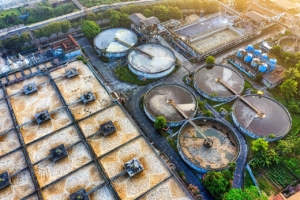The Bipartisan Infrastructure Law allocated the largest amount of funding ever to be invested in the country’s water resources. More than $50 billion was earmarked to specifically improve the country’s drinking water, wastewater, and stormwater infrastructure. In addition to that funding, almost every state has also increased its funding commitments to improving water infrastructure. Water projects of all types are currently on the drawing boards or in the planning stages throughout the U.S. A few examples of what can be expected are described here.
The governor of North Carolina recently announced that the state would invest $3.3 billion in water projects over the next two years. The city of Lexington was one of the first cities to receive funding and that grant totaled $28 million. A project, already in the planning phase, will be launched in 2024 to upgrade the city’s wastewater treatment plant, construct a new dewatering facility and build a new facility for the city’s thermal dryer equipment.
A large $100 million project to deliver a new water treatment plant will be launched in Columbus, Ohio. An engineering firm has been selected to design the plant, which will be the fourth plant located in the area. It will be structured to increase the city’s water capabilities by about 50 million gallons a day. The project is moving swiftly because a large $20 billion industrial Intel plant will be built in the New Albany area. Additionally, the current population growth is significant. The new water plant will increase the city’s ability to provide treated water by about 50 million gallons a day.
A massive water treatment plant expansion along with upgrades to pipes and a wastewater facility has been announced by city officials in Florence, South Carolina. The project has been tagged with a $500 million cost projection and it will be located beside the existing plant. Planning is underway for the water treatment plant as it has become a high priority that resulted from construction of a large AESC US electric car battery plant that broke ground in June.
The design phase of a New Horn Pond treatment plant in Woburn, Massachusetts will be completed by September and construction will begin shortly after city officials approve the design. An estimated cost of $22 million has been projected and a completion date of May 2025 is the goal. The project’s object is to filter out polyfluoroalkyl substances (PFAS). Because this upcoming project is moving rapidly, interested contractors should reach out for more information and meetings very soon. Because the new structure will be erected over the current site of two city wells, the work will also include the reinstallation of that pumping equipment.
City leaders in Mobridge, South Dakota will soon oversee a project to tear down a half-million-gallon water tower and improve its water plant significantly. The project, scheduled for launch in 2024, will include three components, or phases. The first effort will be to replace the current water intake system and then work will begin on a rehabilitation project that will focus on the current water treatment plant. The third phase will focus on the installation of a new and much larger ground storage tank. When completed, the amount of water that can be stored will provide much greater waterpower and benefit the citizens in numerous ways. The city has $11 million to begin the work.
A $76.8 million new main lift station project may be launched in Terre Haute, Indiana. The project was approved to replace an old existing station built in the 1060s. It will have the capability to provide 96 million gallons of water daily and that will almost double the current capacity. Other improvements are planned as well. It is anticipated that project design will begin in late 2023 with permitting completed by late 2024. Construction will begin once the permits have been obtained.
In July, city officials in St Helens, Oregon approved $2.5 million in funding for the design, engineering, and environmental review for a new sanitary sewer improvement project. The planned upgrades will increase the size of sewer mainlines on numerous streets. The project’s objective will be to reduce the risks of sewer overflows into the collection system. Another component of the project will focus on reducing the inflow and infiltration in the collection system and provide more capacity for future growth. The project currently has a projected cost of $16.4 million.
Sewer upgrades will also be the focus of a $13 million project in Metropolis, Illinois. This project is scheduled for bidding to begin in January of 2024. It will require work on sewer plant components that include relocating and installing several lift stations and numerous other upgrades. The city hopes to wrap up improvements that have been lingering for many years with this current effort.
Water project funding is currently flowing from the federal government and at the state levels of government as well. A water project of any specific type and/or size can be found currently in almost every state in the U.S. Many regions are replacing all old and corroded water pipes that exist. New water treatment plants and clean water projects are being launched weekly. The demand for private sector contracting partners will be extremely high over the next three years at the very least.







